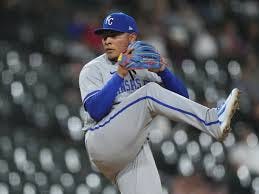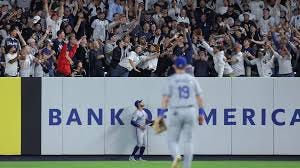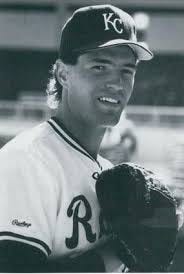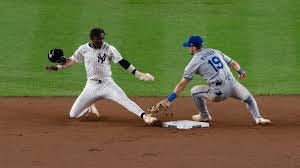Just in case you were wondering: turns out it’s hard to win one-run games when you walk eight batters and two of those walks come with the bases loaded.
As a very smart baseball coach once said to me (once again it was Rusty Kuntz) 3-run homers cover up a lot of mistakes, but if you don’t hit a lot of 3-run homers you better play clean baseball.
Last night the Royals didn’t and it cost them.
Another very smart baseball coach (this time it’s Tim Bogar) told me to pay attention to walks that score and in Game 1 of the ALDS, assuming I counted right, three Yankee walks scored and if you’re looking for a bright spot – and why wouldn’t you – the Royals showed if they had played clean baseball they probably would have beaten the Yankees.
The Royals don’t have a lot of margin for error and last night they made too many mistakes to win, so they need to get that throwing strikes thing cleaned up ASAP.
And now let’s talk about pitchers.
Averages Are Not Constants
So here’s the deal on managing by the numbers: it covers your ass because when it doesn’t work you can always say you did what the numbers told you to do, which is a Big Part of why teams are now using so many pitchers per game (last night the Royals used six) — teams are looking for good match-up numbers.
But that treats “averages” (a number made up of highs and lows) like “constants” (a factor that doesn’t change) and a good pitcher isn’t good every night.
For instance: Royals reliever Angel Zerpa’s 2024 regular-season ERA was 3.86, last night it was 9.00. Sam Long’s 2024 regular-season ERA was 3.16, last night it was 4.50. Michael Lorenzen’s 2024 regular-season ERA was 3.31, last night it was 6.75.
Bottom line: every time a manager goes to his bullpen he runs the risk of finding a pitcher who doesn’t have it that night and last night Matt Quatraro found a bunch of them.
So Why Pull Wacha?
In the Old Days when men were men and sheep were nervous, a manager’s job was to get as much as possible out of his starting pitcher and then pull him right before the other team got to him.
Anyone – including precocious kindergartners, Trump supporters and amateurs who think day trading in the stock market is a good way to get rich – can wait until after a pitcher gets his ass handed to him and make the switch.
So a good manager looks for signs that his pitcher is losing it and Michael Wacha’s last four pitches to Gleyber Torres were at the top or above the strike zone and three were changeups and one was a sinker, all pitches that are supposed to be thrown to the bottom of the zone, and getting pitches up in the zone is a sign a pitcher is gassed.
(Bending all the way over – like chest-to-knee over – and finishing off pitches is really tiring so when pitchers get gassed they might quit doing it and their pitches stay up.)
And after the walk to Torres, left-handed Juan Soto was coming up and with Wacha showing signs of tiring, getting the lefty reliever Angel Zerpa in to face him made sense.
However…
What doesn’t make sense is the bullshit rule that says a reliever has to face three batters which they came up with because analytics and multiple pitching changes had slowed games down so much.
Zerpa was clearly all over the place and Matt Quatraro couldn’t react to what he was seeing until Zerpa faced three batters and after three batters Zerpa had walked in the tying run.
Why 3-0 Strikes Should Piss You Off
Go back to that Austin Wells bases-loaded walk and once Zerpa went 3-0 he threw the next three pitches down the middle for strikes which always pisses me off because those 3-0 pitches demonstrate a pitcher can throw strikes, he’s just reluctant to do it.
They fall behind because they’re trying to hit half-a-microbe on the corners and avoid contact because front offices love strikeouts, but sometimes you have to force contact and let your teammates help you out and the late, great Dan Quisenberry once told me he became a better pitcher once he quit trying to strike people out and let the seven guys standing behind him earn their money.
Lead-off Walks and Slow Runners
Lead-off walks (and we saw way too many of them last night) are considered the worst kind of walk because it gives a team all three outs to move that walk around the bases, although I gotta think bases-loaded walks are right up there on the stone tablet engraved list of:
SHIT YOU NEVER WANNA DO IN A BALLGAME.
(Although I immediately take that back because I once saw Wade Davis walk Miguel Cabrera with a two-run lead and the bases loaded and after the game when I asked Wade if he did it on purpose, he smiled and said: “One run’s better than four.” But Miguel in his prime wasn’t playing last night, so let’s move on.)
When Salvador Perez singled to start the second inning my first thought was “It’s going to take three more hits to score him” because Sal doesn’t run that well and tends to do it 90 feet at a time.
Which reminds me…back when people thought a Billy Butler walk was good thing, his teammates were privately saying if pitchers fall behind Billy they’re just going to walk him because he clogs the bases and forces us to play the game 90 feet at a time and when Billy hits a single most of us think, “Make it a double or don’t bother.”
Considering Sal’s limitations when running the bases I was surprised when third base coach Vance Wilson waved Perez home on MJ Melendez’ single to right field especially because there were no outs.
Baseball Rule of Thumb: With no outs take no chances on the bases because you might have a big inning coming, with one out take chances to get to third base because then you can score without a hit (assuming one run is meaningful) and with two outs take chances to score or get to second base because then you can score on a single.
I wasn’t there to ask Vance, but…
One of the signs you can take an extra 90 feet is an outfielder moving sideways to field the ball because then he’ll throw from a dead stop, but while Soto was moving sideways when Vance waved Perez home, the Yankees right fielder did a great job of curving his route so he was moving forward when he threw the ball and that right there is why Route Efficiency is a dumb number created by people who apparently don’t play or understand baseball.
Route Efficiency is based on the mistaken idea that the best route to a ball is a straight line and as Soto proved, it’s not: whenever possible good outfielders curve their routes and field balls while heading back toward the infield because it makes their throws stronger.
Having said all that, there might have been a reason Vance did what he did – like maybe they decided pregame they had to be incredibly aggressive on the bases and Vance read Soto’s sideways movement – but with no outs and Sal running, it turned out to be a bad bet.
So What’s The Deal On All Those High Fastballs?
So Baseball goes Cuckoo for Cocoa Puffs when it comes to home runs and to get the ball in the air you have to hit the bottom half and some hitters developed a loop in their swings to make that job easier.
But pitchers adjust right back and now you see them blow high fastballs past loopy-swing hitters looking for pitches up in the zone and one of the pitching philosophies is to figure out what a hitter wants to hit and then give him way too much of it.
If he wants to pull, run sliders and cutters in on his hands and if he wants the ball on the outer half, run those sliders and cutters away off the plate and if he wants a pitch up, throw it above the zone he can handle, but make sure you get it up there because miss six inches down and you just gave him the pitch he was looking for.
We saw the Royals throw a lot of high fastballs to the home-run hitting Yankees and I’m guessing you’ll see a lot more of them in the rest of the series.
And Now Some Other Stuff
Pay attention to the catcher’s mitt and how much it moves which will tell you a lot about the pitcher’s control and on Gleyber’s home run, Perez was showing the target inside and Wacha didn’t get it there. Also…according to the Kansas City Star, Yankee Stadium is the only ballpark in the Major Leagues where Gleyber’s fly ball would be a homer. The Royals pitchers need to be careful coming inside to lefties or up and away on righties.
The Yankees sent eight men to the plate in the bottom of the fifth and scored two runs and while that seems like a pretty good deal for the Yankees, anytime a team has a long inning on offense their starting pitcher is sitting and getting cold and when Gerrit Cole came back out for the top of the sixth he threw two pitches down the middle, gave up a single and was pulled from the game.
Cole, who wears his heart on his sleeve and a scowl on his face, could be seen pacing around and being visibly unhappy throughout the sixth and it’s considered good baseball etiquette for pitchers to stick around and watch their teammates deal with whatever emergency they got started.
After that inning ends the pulled pitcher is then free to go up to the clubhouse and throw shit and scream and a clubhouse manager once confirmed the biggest “snappers” (a “snap” is a baseball tantrum) are starting pitchers who got pulled early and then find themselves all alone in the clubhouse with nothing better to do than break shit. And apparently one of the best snaps came from former Royals pitcher Mark Gubicza who had a lousy game, then took every beer in the Royals clubhouse and hit them off a batting tee.
If you want to see what that looks like (I did and it’s pretty spectacular) here’s a story and a video:
https://www.kansascity.com/sports/mlb/kansas-city-royals/article211176389.html
After a snap is over and the pitcher regains what’s left of his sanity, he’s supposed to pay for everything he broke so destroying a case of beer is a better bargain than a wrecking a flat-screen TV or a leather couch and “snaps” are now more expensive than back when a player might throw a wooden stool against a concrete wall because these days clubhouses are much nicer.
(See? You learn something every day as long as you don’t walk around assuming you already know everything.)
At one point in last night’s game TV announcers Bob Costas and Ron Darling were talking about Shohei Ohtani and Bob said Japanese and Latin players often speak more English than they let on (it keeps them from having to talk to reporters all the time) and then referred to his famous interview with Ichiro Suzuki and how Ichiro answered when Bob asked what his favorite American expression was, but then Bob said it couldn’t be repeated on TV, but I already knew what Suzuki said and now here’s that video:
I actually have a lot more notes from last night’s game including one about the bad call on Jazz Chisolm’s stolen base (and next time they say his name definitely don’t think how close it is to Jizz Chasholm which sounds like a porn star who also plays baseball and I think about it every time he gets mentioned because unfortunately that’s how my mind works and now you can’t unread this and I’d bet good money you’ll think it too).
Anyway…
The replay officials (who happen to be based in New York) didn’t overturn that bad call and it cost the Royals a run and made me wonder why we go to so much trouble to provide replays and supply a guy to explain how the umpires and referees aren’t actually blind and according to Madison vs. Marbury, made the right call, but still get so many calls wrong.
On the other hand…
If you don’t walk eight batters it wouldn’t hurt as much.
Take a rest (even God took a day off) and we’ll be back at it on Monday and hope the Royals play a clean game because what they did last night won’t cut it.
But they were close.








Watching all those walks last night, I thought it was one of the most painful games I’d ever seen. It felt longer than 3 hours and 21 minutes. So fucking close!! Oops gotta hit the goddamn swear jar.
But I really enjoyed your column about Snapping. I hit pillows sometimes.